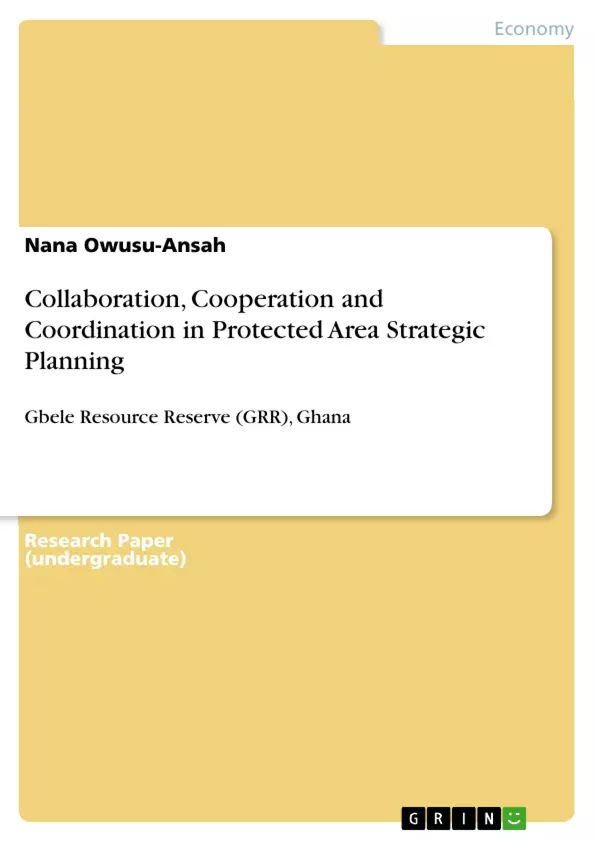Strategic planning involves decision makers at different levels discussing key issues of an organization in a structured manner. The structured steps include developing initial agreement for the strategic plan effort which provides the role and responsibilities of the team, the timing of reporting, processes and membership of the team. With the plethora of actors with different roles and responsibilities to ensure a successful production and implementation of an organization strategic plan; the need for collaboration, cooperation and coordination (3Cs) is imperative which must be champion by a sponsor. Protected areas for wildlife conservation found themselves in the category of organizations operating in a shared environment. Community collaborative wildlife management has emerged as one of the strategies to ensure wildlife resource sustenance (Larsen, 2006; Jachmann, 2007) because it is difficult to have on the spot policing. Gbele Resource Reserve (GRR) is a wildlife protected area in an environment of fringe communities having competing stakes with wildlife resources through poaching amidst wildlife law enforcement by the managers of the reserve.
Key Words: collaboration, cooperation, coordination, conservation, poaching, wildlife
Inhaltsverzeichnis (Table of Contents)
- Incorporating the 3Cs in Strategic Planning
- Abstract
- Collaboration, Cooperation and Coordination in Protected Area Strategic Planning
- Gbele Resource Reserve (GRR) Profile
- GRR Mandate, Mission, Vision and Activities
Zielsetzung und Themenschwerpunkte (Objectives and Key Themes)
This document examines the importance of collaboration, cooperation, and coordination (3Cs) in the strategic planning process of protected areas. The author focuses on the Gbele Resource Reserve (GRR) in Ghana, a wildlife protected area with a complex relationship to surrounding communities.
- The need for strategic planning and its benefits for organizations
- Challenges of strategic planning, particularly in a shared environment with competing stakeholders
- The crucial role of collaboration, cooperation, and coordination in facilitating successful strategic planning within protected areas
- The case of the Gbele Resource Reserve (GRR) and its challenges related to poaching, community access, and resource management
- Strategies for building public value and balancing the needs of both wildlife conservation and local communities
Zusammenfassung der Kapitel (Chapter Summaries)
The text begins by outlining the significance of strategic planning and the need for a structured process. It highlights the challenges of planning in a shared environment with diverse stakeholders, emphasizing the crucial role of collaboration, cooperation, and coordination (3Cs). The document then focuses on the Gbele Resource Reserve (GRR) in Ghana, providing a profile of the reserve and its mandate, mission, and vision. The text explores the complex relationship between GRR and the surrounding communities, acknowledging the challenges posed by poaching and competing demands for resources. It also highlights the need for GRR to create public value and balance its mandate for wildlife conservation with the socio-economic needs of local communities.
Schlüsselwörter (Keywords)
The primary keywords and focus topics of this text are collaboration, cooperation, coordination, strategic planning, protected areas, wildlife conservation, poaching, community engagement, public value, and resource management. The text explores the importance of incorporating these key concepts into the strategic planning process of protected areas to ensure long-term success and sustainability.
- Quote paper
- Nana Owusu-Ansah (Author), 2014, Collaboration, Cooperation and Coordination in Protected Area Strategic Planning, Munich, GRIN Verlag, https://www.grin.com/document/283070



